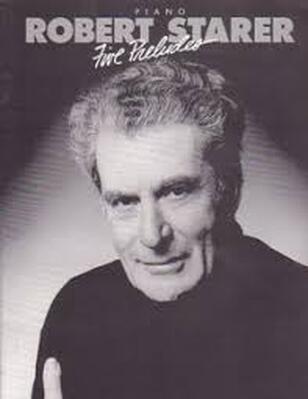These recordings are not to be downloaded
ROBERT STARER
FIVE MINIATURES
(1949)

ROBERT STARER (b. 1924 - d. 2001) received his musical education at the State Academy in Vienna, the Jerusalem Conservatoire and the Juilliard School. He became an American citizen in 1957. His stage works include three operas and several ballets for Martha Graham, Herbert Ross, and Anna Sokolow. His symphonic works have been performed here and abroad by major orchestras under Mitropoulos, Bernstein, Leinsdorf, Steinberg, Comissiona, and Ozawa. Honors include two Guggenheim Fellowships and an award from the American Academy and Institute of Arts & Letters.
To listen to this 1973 performance at
Washington and Lee University
Lexington, Virginia
by the
Annapolis Brass Quintet
Haldon Johnson, trumpet; David Cran, trumpet;
Calvin Smith, horn; David Kanter, trombone;
Robert Posten, bass trombone.
of
Five Miniatures
for brass quintet
(1949)
by
Robert Starer
(Duration: 06' 31")
Tap > Below
(There may be a slight delay before sound begins.)
Washington and Lee University
Lexington, Virginia
by the
Annapolis Brass Quintet
Haldon Johnson, trumpet; David Cran, trumpet;
Calvin Smith, horn; David Kanter, trombone;
Robert Posten, bass trombone.
of
Five Miniatures
for brass quintet
(1949)
by
Robert Starer
(Duration: 06' 31")
Tap > Below
(There may be a slight delay before sound begins.)
Five Miniatures
1. Fanfare 2. Air 3. Canon 4. Chaconne 5. March
1. Fanfare 2. Air 3. Canon 4. Chaconne 5. March
The following is excerpted from an early review of Robert Starer's 1949 Five Miniatures for brass quintet:
Starer's harmonic vocabulary is expressive, his rhythmic resources are richly varied, and both appear to trace their ancestry to the folk music of eastern Europe. The opening Fanfare resembles in no wise the traditional potpourri of trumpet calls; it convinces on musical terms rather than by systolic stimulation. The Air is overlaid on a quasi-ostinato of seven-eighths in a 4/4 bar, with the instruments muted throughout. A Chaconne with only two variations after the initial statement appears somewhat truncated; one would like to have it continued for several more, but that would necessarily eliminate it from this set on grounds of length. The concluding March uses flutter-tongue, cuivre horns, and an occasional trombone glissando. Frequent meter changes (2/4, 3/4, 4/4, 6/4, 7/4) all seem quite natural and do not detract from the marchlike character of the piece. All in all, this is a real contribution to the brass literature.
~ author unknown
Starer's harmonic vocabulary is expressive, his rhythmic resources are richly varied, and both appear to trace their ancestry to the folk music of eastern Europe. The opening Fanfare resembles in no wise the traditional potpourri of trumpet calls; it convinces on musical terms rather than by systolic stimulation. The Air is overlaid on a quasi-ostinato of seven-eighths in a 4/4 bar, with the instruments muted throughout. A Chaconne with only two variations after the initial statement appears somewhat truncated; one would like to have it continued for several more, but that would necessarily eliminate it from this set on grounds of length. The concluding March uses flutter-tongue, cuivre horns, and an occasional trombone glissando. Frequent meter changes (2/4, 3/4, 4/4, 6/4, 7/4) all seem quite natural and do not detract from the marchlike character of the piece. All in all, this is a real contribution to the brass literature.
~ author unknown
FOSTERING BRASS CHAMBER MUSIC
The score and parts for Robert Starer's Five Miniatures for brass quintet, along with the entire ABQ music library, are available for research and performance from the Oberlin Conservatory of Music Library.
Direct access to the Annapolis Brass Quintet Special Collection @ Oberlin
Tap Here
The score and parts for Robert Starer's Five Miniatures for brass quintet, along with the entire ABQ music library, are available for research and performance from the Oberlin Conservatory of Music Library.
Direct access to the Annapolis Brass Quintet Special Collection @ Oberlin
Tap Here
